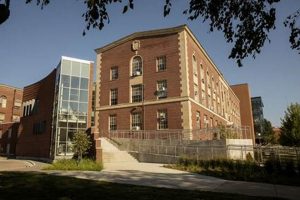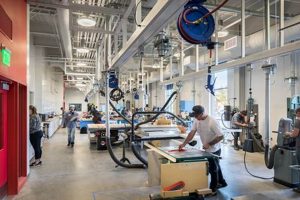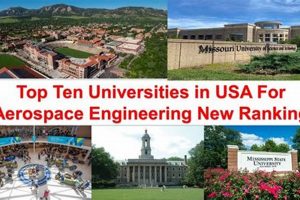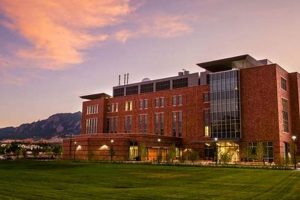The John D. Odegard School of Aerospace Sciences at a state institution in Grand Forks, North Dakota, represents a significant center for aviation and space-related education, research, and training. This academic division provides a wide array of undergraduate and graduate programs, preparing individuals for various roles within the aerospace industry, including pilots, air traffic controllers, aerospace engineers, and aviation managers.
Its significance lies in its comprehensive approach to aerospace education, encompassing flight training, academic coursework, and research opportunities. The school’s large fleet of aircraft and advanced simulation technologies offer students practical, hands-on experience. Furthermore, its long-standing history and established reputation contribute significantly to the workforce pipeline for the aviation sector, both regionally and nationally.
The following sections will delve into specific aspects of the program, including its curriculum, training facilities, research initiatives, and contributions to the broader aerospace field.
Guidance for Aspiring Aerospace Professionals
The ensuing information offers insights applicable to individuals considering a career path in the aerospace industry, drawing upon observations from a prominent academic institution focused on this domain.
Tip 1: Cultivate a Strong Foundation in STEM Disciplines: A solid understanding of science, technology, engineering, and mathematics is paramount. Coursework in physics, calculus, and computer programming provides essential building blocks for success in aerospace studies.
Tip 2: Seek Hands-On Experience: Supplement academic learning with practical experience whenever possible. Opportunities such as internships at aerospace companies, participation in aviation clubs, or involvement in research projects enhance skill development and industry knowledge.
Tip 3: Develop Effective Communication Skills: The ability to communicate technical information clearly and concisely is critical. Practice written and oral communication skills through presentations, report writing, and group projects.
Tip 4: Prioritize Safety and Professionalism: Adherence to safety protocols and ethical conduct are non-negotiable in the aerospace sector. Emphasize these principles throughout training and career development.
Tip 5: Understand Regulatory Frameworks: Familiarize oneself with the regulatory environment governing aviation and space activities. Knowledge of FAA regulations, international treaties, and industry standards is essential.
Tip 6: Embrace Lifelong Learning: The aerospace field is characterized by continuous technological advancements. A commitment to ongoing professional development ensures relevance and adaptability.
These guidelines emphasize the necessity of a robust educational foundation, practical experience, strong communication skills, and a commitment to safety and continuous learning. Adhering to these principles can enhance an individual’s prospects for success within the aerospace field.
The subsequent discussion will provide a concluding overview of the key themes presented.
1. Comprehensive Flight Training
Comprehensive flight training forms a cornerstone of aviation education, particularly within the academic framework of an institution such as that based in North Dakota. This training encompasses a structured curriculum designed to equip aspiring pilots with the skills, knowledge, and judgment necessary for safe and efficient flight operations. Its importance extends beyond mere technical proficiency, fostering critical thinking, decision-making, and risk management abilities.
- Structured Curriculum and Flight Hours
The flight training program integrates ground school instruction with practical flight experience, adhering to Federal Aviation Administration (FAA) regulations. Students accumulate flight hours under the guidance of certified flight instructors, progressing through various stages of training, including basic maneuvers, navigation, instrument flying, and advanced aircraft operations. For example, a typical program might include 250+ flight hours by the time students earn a commercial pilot certificate.
- Utilization of Flight Simulators
Advanced flight simulators play a crucial role in modern flight training. These devices replicate various flight conditions, including adverse weather, equipment malfunctions, and emergency scenarios, allowing students to practice responses in a safe and controlled environment. The use of simulators enhances learning efficiency and reduces the risk associated with in-flight training. This is particularly valuable in preparing students for scenarios they might not encounter during normal flight operations.
- Emphasis on Safety and Regulatory Compliance
Safety is paramount in flight training, and programs instill a strong safety culture from the outset. Students learn to identify and mitigate risks, adhere to standard operating procedures, and comply with FAA regulations. Emphasis is placed on pre-flight inspections, weather analysis, and aircraft performance calculations. Strict adherence to regulatory requirements ensures that graduates meet the necessary standards for professional piloting.
- Development of Crew Resource Management (CRM) Skills
Modern aviation emphasizes teamwork and effective communication within the cockpit. Flight training programs incorporate CRM principles, teaching students how to coordinate with crew members, share information, and make collaborative decisions. These skills are essential for operating multi-crew aircraft and contribute significantly to flight safety. Through realistic scenarios and simulations, students learn to apply CRM principles in demanding situations.
The integration of a structured curriculum, flight simulators, safety protocols, and CRM training ensures that graduates are well-prepared for the challenges of a professional piloting career. These elements, as exemplified by the program discussed, contribute to the institution’s reputation for producing highly skilled and safety-conscious aviation professionals, equipped to navigate the complexities of modern aviation.
2. Advanced Simulation Technology
Advanced simulation technology serves as an integral component within the educational framework. Its presence significantly enhances the training capabilities, mirroring the complexities of real-world flight environments with fidelity. Cause and effect are directly observable: the utilization of sophisticated flight simulators improves student proficiency and preparedness for operational scenarios. Without such technology, the scope and realism of training would be considerably limited, impacting the quality of graduates entering the aviation sector.
The utilization of advanced simulation technology extends beyond basic flight training. High-fidelity simulators enable the replication of rare or hazardous conditions, such as engine failures, severe weather encounters, and system malfunctions, offering a safe and controlled environment for students to develop critical decision-making skills. An example involves the use of full-motion simulators to train pilots in handling windshear, a dangerous weather phenomenon that can lead to accidents. This practical application allows students to experience the physiological and psychological effects of windshear without the inherent risks of in-flight training. Furthermore, simulation technology is used extensively for research, enabling faculty and students to investigate human factors, pilot performance, and the effectiveness of new flight procedures.
In summary, advanced simulation technology constitutes a vital asset. It augments the educational process through enhanced realism and safety, thereby producing more competent and adaptable aviation professionals. The ongoing integration and advancement of simulation capabilities remains critical to maintaining a leading position in aerospace education, ensuring graduates are well-equipped to meet the challenges of a rapidly evolving industry.
3. Renowned Aviation Research
A significant component of the academic and operational environment within the North Dakota-based institution centers around its commitment to aviation research. This research spans a variety of disciplines, contributing both to the advancement of theoretical knowledge and to practical improvements within the aerospace industry.
- Unmanned Aircraft Systems (UAS) Research
The institution engages in extensive research related to UAS, including flight operations, airspace integration, and applications in various sectors such as agriculture, infrastructure inspection, and disaster response. This research helps to shape regulations, develop operational best practices, and expand the potential uses of UAS technology. An example is its work on developing detect-and-avoid systems for UAS to enable safe operation in controlled airspace, contributing to the broader integration of drones into the national airspace system.
- Human Factors and Pilot Performance
Research focuses on understanding the impact of human factors, such as fatigue, stress, and cognitive workload, on pilot performance. Studies investigate methods to mitigate these effects and improve pilot training, flight deck design, and operational procedures. For instance, research examines the effectiveness of different cockpit displays and automation systems in reducing pilot workload and enhancing situational awareness. The findings inform the development of more user-friendly aircraft interfaces and more effective training programs.
- Air Traffic Management (ATM) and NextGen Technologies
Research initiatives explore advancements in ATM systems and the implementation of NextGen technologies aimed at improving air traffic efficiency, safety, and capacity. Studies investigate new concepts for airspace design, traffic flow management, and communication, navigation, and surveillance technologies. A specific area of focus includes the development of tools and procedures to support performance-based navigation (PBN) and trajectory-based operations, contributing to a more efficient and flexible air traffic system.
- Aviation Safety and Security
Research addresses critical issues related to aviation safety and security, including accident investigation, risk assessment, and the development of safety management systems (SMS). Studies investigate the causes of aviation accidents and incidents, identify potential hazards, and develop strategies to prevent future occurrences. The institution collaborates with industry partners and regulatory agencies to improve safety standards and promote a culture of safety within the aviation community. For instance, research is conducted on improving runway safety through enhanced lighting systems and improved procedures for preventing runway incursions.
The aviation research activities undertaken by this academic organization not only enhance its reputation as a center of excellence but also contribute significantly to the overall advancement of the aerospace industry. The research findings inform policy decisions, improve operational practices, and ultimately enhance the safety, efficiency, and sustainability of air transportation.
4. Industry-Aligned Curriculum
The Odegard School’s curriculum prioritizes alignment with the aerospace industry’s evolving needs. This alignment is not a passive adaptation; rather, it is a proactive and continuous process. The institution actively solicits feedback from industry stakeholders, including airlines, aerospace manufacturers, and government agencies, to ensure its programs remain relevant and responsive to the demands of the modern aviation workforce. This collaborative approach directly influences course content, skill development objectives, and the integration of emerging technologies into the curriculum. A demonstrable effect of this focus is the high rate of graduate placement within the aerospace sector.
Specific examples of industry alignment include the integration of advanced avionics systems into flight training, reflecting the technological advancements in modern aircraft. Furthermore, the curriculum incorporates training on safety management systems (SMS) and human factors, addressing critical areas of concern within the industry. The school also offers specialized programs in areas such as unmanned aircraft systems (UAS) and air traffic control, reflecting the growing importance of these fields. These programs provide students with targeted skills and knowledge, preparing them for specific career paths within the aerospace industry. The practical significance of this alignment is evident in the graduates’ ability to seamlessly transition into industry roles, requiring minimal on-the-job training.
In summary, the emphasis on an industry-aligned curriculum is a defining characteristic. This commitment to relevance ensures that graduates are not only academically prepared but also possess the practical skills and knowledge required to succeed in the dynamic and competitive aerospace industry. A potential challenge lies in maintaining this alignment amidst rapid technological advancements, requiring continuous adaptation and collaboration. The benefits of this proactive approach, however, are clear: a highly skilled workforce that drives innovation and ensures the continued growth and safety of the aerospace sector.
5. Global Aviation Influence
The Odegard School’s global aviation influence stems from its extensive international collaborations, diverse student body, and the worldwide deployment of its graduates. A significant portion of the institution’s student population originates from countries outside the United States, fostering a multicultural learning environment and broadening perspectives on global aviation practices. Graduates of the program are employed by airlines and aerospace organizations worldwide, effectively disseminating the knowledge and training acquired at the institution across international boundaries. The effect is a global network of aviation professionals trained under a common pedagogical framework, promoting standardized practices and enhancing safety standards.
The institution actively cultivates partnerships with foreign universities and aviation training organizations, facilitating student exchange programs and collaborative research initiatives. For example, agreements with universities in Asia and Europe enable students to gain international exposure and experience different aviation regulatory environments. Additionally, faculty members participate in international conferences and workshops, sharing expertise and contributing to the development of global aviation standards. The practical application of this global influence is evident in the adoption of training methodologies and safety protocols developed at the institution by aviation organizations worldwide.
In summary, the institution’s global aviation influence is a multifaceted phenomenon, driven by its international student population, alumni network, collaborative partnerships, and research contributions. This influence not only enhances the institution’s reputation but also contributes significantly to the standardization and advancement of aviation practices worldwide. A continued emphasis on global engagement remains crucial for maintaining a leading position in aerospace education and fostering a safer, more efficient, and interconnected aviation industry.
Frequently Asked Questions Regarding the University of North Dakota Aerospace Program
The following addresses common inquiries concerning the curriculum, facilities, and overall experience offered within the institution’s aviation and aerospace programs.
Question 1: What are the primary academic pathways available?
The institution provides a spectrum of undergraduate and graduate degree programs, encompassing fields such as aviation management, air traffic control, unmanned aircraft systems, and aviation safety. Furthermore, traditional pilot training leading to commercial certification is a core offering.
Question 2: What distinguishes the flight training program from others?
The program is characterized by its large and diverse fleet of aircraft, a robust emphasis on safety, and the integration of advanced simulation technologies. Moreover, the program benefits from a long-standing reputation and established relationships within the aviation industry.
Question 3: Are there opportunities for research within the aerospace department?
Yes, active research is conducted across various areas, including unmanned aircraft systems, human factors, air traffic management, and aviation safety. Students are encouraged to participate in research projects under the guidance of faculty members.
Question 4: What career prospects are available to graduates of the program?
Graduates pursue a wide range of careers within the aerospace industry, including airline pilots, air traffic controllers, aviation managers, aerospace engineers, and safety specialists. The institution’s strong industry connections facilitate job placement opportunities.
Question 5: What qualifications are required for admission into the flight training program?
Admission requirements vary depending on the specific program. Generally, a strong academic record, aptitude for mathematics and science, and the ability to pass required medical examinations are essential. Specific prerequisites can be found on the university’s official website.
Question 6: Are there opportunities for financial assistance or scholarships?
The institution offers various forms of financial aid, including scholarships, grants, and student loans. Eligibility criteria vary, and prospective students are encouraged to explore available options through the university’s financial aid office.
The information presented aims to provide clarity regarding the key aspects of the aviation and aerospace programs. Prospective students and stakeholders are encouraged to consult official university resources for detailed information.
The subsequent section will provide information concerning the application process for prospective students.
Conclusion
This exposition has detailed various facets of the University of North Dakota Aerospace program, emphasizing its robust curriculum, advanced training facilities, research initiatives, and global impact. The program’s commitment to industry alignment, safety, and innovation has been demonstrably highlighted, emphasizing its role in cultivating future leaders within the aviation and aerospace sectors.
As the aerospace industry continues to evolve, institutions such as the University of North Dakota Aerospace will remain critical in providing the necessary education and training to meet future challenges. Further exploration of the resources and opportunities offered by the program is encouraged for those seeking to contribute to this vital and dynamic field.




![Top Aerospace Engineering at York University [Your Future] Innovating the Future of Flight with Reliable Aviation Solutions Top Aerospace Engineering at York University [Your Future] | Innovating the Future of Flight with Reliable Aviation Solutions](https://mixaerospace.com/wp-content/uploads/2025/10/th-476-300x200.jpg)


